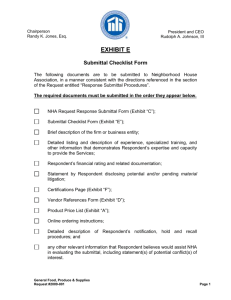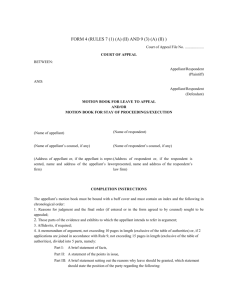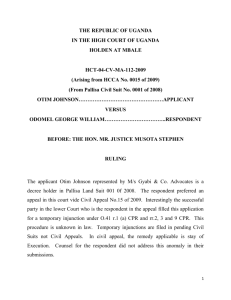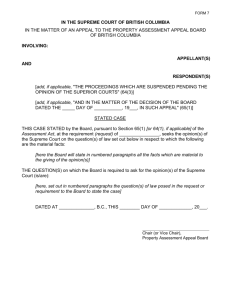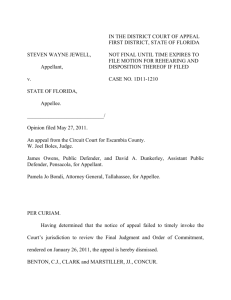Anglogold Ashanti vs George Siaw Yeboah
advertisement
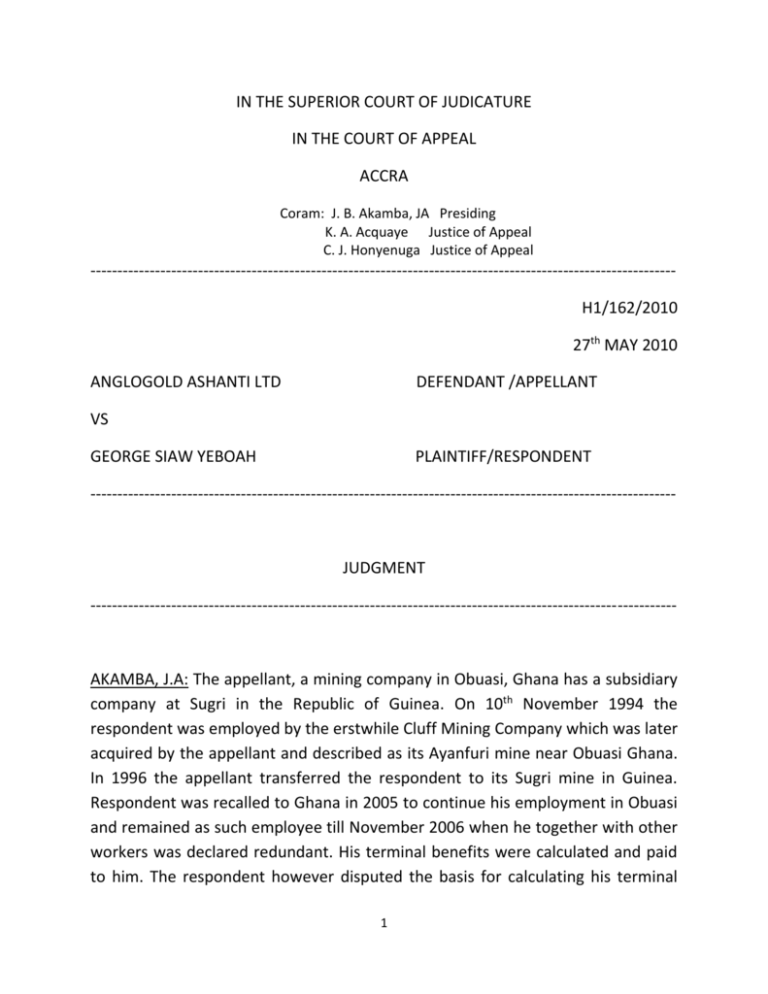
IN THE SUPERIOR COURT OF JUDICATURE IN THE COURT OF APPEAL ACCRA Coram: J. B. Akamba, JA Presiding K. A. Acquaye Justice of Appeal C. J. Honyenuga Justice of Appeal ------------------------------------------------------------------------------------------------------------H1/162/2010 27th MAY 2010 ANGLOGOLD ASHANTI LTD DEFENDANT /APPELLANT VS GEORGE SIAW YEBOAH PLAINTIFF/RESPONDENT ------------------------------------------------------------------------------------------------------------- JUDGMENT ------------------------------------------------------------------------------------------------------------- AKAMBA, J.A: The appellant, a mining company in Obuasi, Ghana has a subsidiary company at Sugri in the Republic of Guinea. On 10th November 1994 the respondent was employed by the erstwhile Cluff Mining Company which was later acquired by the appellant and described as its Ayanfuri mine near Obuasi Ghana. In 1996 the appellant transferred the respondent to its Sugri mine in Guinea. Respondent was recalled to Ghana in 2005 to continue his employment in Obuasi and remained as such employee till November 2006 when he together with other workers was declared redundant. His terminal benefits were calculated and paid to him. The respondent however disputed the basis for calculating his terminal 1 benefit as the same failed to take into account the period he worked as an expatriate in the Republic of Guinea. The respondent drew the attention of the appellant to the apparent miscalculation of his entitlements but this view was not shared by the appellant. Following the stalemate the respondent initiated an action at the Automated High Court Accra to claim what he perceived as due him. The High court entered judgment in favour of the respondent hence this appeal. In this appeal three grounds were formulated for determination by this court. These are that: (i) (ii) (iii) The learned trial judge erred in holding that the calculation of the plaintiff’s entitlements must include an amount for the period while he was engaged abroad. The trial judge erred in holding that the plaintiff who was re-engaged on his return from abroad qualified as a category A or B employee. The learned trial judge misconstrued the legal clauses 4.2.1, 4.2.2 or 4.2.4, as applying to the plaintiff. The resolution of this appeal just as the initial action before the trial High court hinges upon the true or proper interpretation of the scope of operation of exhibit A. In doing so it is important to state that exhibit A should be considered as a whole to be appreciated. This conforms to a basic rule of construction of documents that a document must be read as a whole in order to ascertain the intentions of the maker and thus give effect to and effectuate the true intentions. This court in the case of Boateng v Volta Aluminium Co. Ltd (1984-86) GLRD 85 approved the indelible dictum of Huddleston B in Wigsell v Corporation of School for Indigent Blind (1880) 43 LT 218 in the following words: “ In construing covenants, the fulfillment of the evident intention and meaning of the parties to them must be looked at, not confining oneself within the narrow limits of a literal interpretation; but taking more liberal and extended view, and contemplating at once the whole scope and object of the deed in which they are contained.” 2 In that case the employment of the appellant, a production supervisor was terminated on being given a month’s salary in lieu of notice. He claimed that the termination was unlawful as it contravened clause 3 of the conditions of his service which required that termination be subject only to the giving of ‘a notice of one month.’ Termination in lieu of notice was not provided for. He therefore by an originating summons sought an interpretation of the clause which provided that “involuntary termination of employment for cause shall require a month’s notice to the terminated supervisor.” The High Court ruled that clause 3 of the conditions of service implied that the employment could be terminated on payment of salary in lieu of notice and therefore the termination of the employment consequent upon payment of salary was not unlawful. On appeal against that interpretation, this Court in dismissing the appeal held that in construing clause 3 regard should be given to all four clauses in the agreement dealing with termination, the language used and all the provisions in the termination clauses should be looked at as a whole and every clause must be compared with the other and an entire sense made out of them with a view to discovering the true meaning and intentions of the parties. This basic approach was also rightly adopted by Abban J (as he then was) in the case of Manu vs Emeruwa (1971) 1 GLR 442 for which I endorse and approve. In that case the plaintiff borrowed money from the defendant for three weeks for which he deposited his car together with all the documents on the car with the defendant as security. The terms of the transaction were embodied in a written document signed by both parties who were illiterates. The car was subsequently damaged by the defendant’s son when he was learning to drive with it. The plaintiff sued for damages for the use or misuse of his car. The issue turned on whether the transaction as embodied in the written agreement was a pledge or a mortgage. The court in determining that issue held that the written document must be read as a whole, that is to say that it must consider certain apparently ambiguous words such as “absolute assignment”, “covenant” and “absolutely” as well as clause 2 of the document which stated that the defendant was to keep the vehicle but to return it to the plaintiff on repayment of the loan. The court per 3 Abban J (as he then was) held that the transaction in the circumstances of the case constituted a pledge. This is what he said: “In cases of this kind, all the terms of the document must be looked at and whatever may be the phraseology adopted or used in some particular part of the document, if on the consideration of the whole document there are grounds appearing on the face of the document affording proof of the real intention of the parties, then that intention ought to prevail against the obvious and ordinary meaning of those words.” The court at page 446 also relied on the following dictum of Lord Willes C.J. in the case of Smith v Packhurst (1714) 26 ER 881 at 881-882: “Another maxim is, that such a construction should be made of the words of a deed, as is most agreeable to the intention of the grantor, the words are not the principal things in a deed, but the intent and design of the grantor; we have no power indeed to alter the words or to insert words which are not in the deed, but we may and ought to construe the words in a manner the most agreeable to the meaning of the grantor, and may reject any words that are merely insensible…the art of construing words in such a manner as shall destroy the intent may shew the ingenuity of counsel, but is very ill becoming a judge.” Bearing the above cited decisions in mind I will deal with the three grounds of appeal together to ascertain the extent of coverage of the exhibit A which is at the centre of this dispute. Exhibit A begins by stating what it is: a “Corporate Policy on transfer/secondment”. It then states its purpose which is to the effect that: “This policy sets out the principles governing the transfer and /or secondment of employees from one location to another on either permanent or temporary basis.” It is not in dispute that the policy (exhibit A) covered the respondent since he was at the time a senior staff. It is also not disputed that whilst the respondent was on transfer to the Sugri mines in Guinea he was accorded an expatriate status for which he drew the appropriate foreign incentive and hardship allowances for the period together with the others stated in exhibit A such as his basic salary in his home country (Ghana) after deductions of provident fund and social security contributions. The crucial question is what 4 provisions are available upon the determination of an employee’s employment? It is clear to me that when Exhibit A is read as a whole that it covers the period, among others, when employees are on transfer or on secondment from their parent mine to other mines or locations and also those who while on such transfer or secondment their contractual relationship with the appellants terminates or comes to an end. For instance item 4.2.2 of exhibit A provides for category A employees who are those employees who while on transfer will continue to be paid their basic salary in their home country and in addition receive foreign incentive and hardship allowances. Other terms and conditions of this category employees on transfer include (g) which provides for what happens when “for any reason, for e.g. closure of mine, downsizing etc., the services of an employee who has been transferred for developmental purposes are not required at the end of the transfer period, the employee will be paid his Provident Fund and the relevant Redundancy package and also be given his social security contribution statement.” It is obvious that this category of employees are those who were transferred or seconded to other locations with the obvious impression that they would return to their home company to continue to work but for such unforeseen circumstances such as the closure of the mine, downsizing etc. In other words this category of employees would ordinarily return to continue work in their home mine but for some unforeseen circumstances. Such employees were those provided under g supra. Item 4.2.3 deals with Category B employees who are those employees transferred to other countries with the understanding that they would not be required to return to work in their home country at the end of the contract. Obviously for the respondent to qualify as a Category A employee his contract should have ended after taking his last leave in Guinea. This not being the case and with him agreeing to transfer back to Ghana to continue to work for the appellant he cannot claim reliance on provision 4.2.2. The respondent did not demonstrate that he was a category B employee who was made aware from the onset that he would not be required to return to Ghana after his tour on secondment. That aside, there is nothing also in exhibit A to suggest that this policy would continue to govern an employee who having once been governed by 5 it would continue to be so governed even on his return to work in his home country (Ghana). It would be noted that it was the respondent who as plaintiff asserted that by the provisions of exhibit A, calculations of his end of term benefits were governed by same. He failed to show that exhibit A operated beyond his period of work in Guinea. Section 14 of the Evidence Act 323 places the burden of persuasion on the party asserting the existence of a fact essential to the claim or defence. Section 17 of the Act (Act 323) explains the burden further thus: “17. Except as otherwise provided by law, a) The burden of producing evidence of a particular fact is on the party against whom a finding on that fact would be required in the absence of further proof; b) The burden of producing evidence of a particular fact is initially on the party with the burden of persuasion as to that fact.” In the suit at the trial court this burden was squarely placed on the respondent as plaintiff but he failed to discharge it. The respondent worked for a total period of twelve years from November 1994 to 2006. As per exhibit 2 his redundancy package was calculated to cover the 12 year period. The package also included what is termed a golden handshake to which he was entitled. As plaintiff in the lower court the respondent did not show as he asserted, by what criterion he desired his end of term or redundancy package ought to be calculated other than what the appellants have meticulously set out for him. He placed heavy premium on exhibit A which ended when he rejoined his parent company in Ghana. The appellants have amply demonstrated that the trial judge’s heavy reliance on exhibit A to order a new calculation was not warranted. The evidence rather supports the conclusion that the calculation of the respondent’s terminal benefits as shown in exhibit 2 was justified. I will allow the appeal and set aside the judgment of the court below which I hereby do. Cost of GH¢500.00 for the Appellants 6 J.B.Akamba Justice of Appeal I agree. K.A. Acquaye Justice of Appeal. I also agree. C.J Honyenuga. Justice of Appeal COUNSEL 1. Mr. Nartey Tettey for Appellants 2. Mr. James Agbedor for Respondents 7

